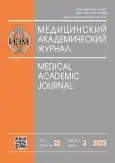Подходы к изучению клеточного иммунного ответа к антигенам SARS-CoV-2 на модели сирийских хомячков
- Авторы: Меженская Д.А.1, Исакова-Сивак И.Н.1, Руденко Л.Г.1
-
Учреждения:
- Институт экспериментальной медицины
- Выпуск: Том 22, № 2 (2022)
- Страницы: 215-220
- Раздел: Материалы конференции
- URL: https://ogarev-online.ru/MAJ/article/view/108629
- DOI: https://doi.org/10.17816/MAJ108629
- ID: 108629
Цитировать
Аннотация
Обоснование. Пандемия, вызванная появлением вируса SARS-CoV-2 в конце 2019 г., все еще остается серьезной проблемой здравоохранения. Ввиду постоянного антигенного дрейфа возбудителя, приводящего к снижению эффективности лицензированных вакцин от COVID-19, актуальна разработка вакцин широкого спектра действия, эффективных в отношении эволюционно удаленных вариантов коронавируса. В отличие от вирусспецифических антител c достаточно узким диапазоном действия, Т-клеточное звено иммунитета обладает более широким кросс-протективным потенциалом. Сирийские хомячки — адекватная модель для доклинической оценки новых вакцинных кандидатов, поскольку эти животные не только чувствительны к новой коронавирусной инфекции, но и способны проявлять клинические симптомы заболевания. Однако тестирование Т-клеточных вакцин на хомяках осложняется отсутствием доступных реагентов и тест-систем, позволяющих адекватно оценивать уровни вирусспецифического клеточного иммунитета на вакцинацию.
Цель работы — оптимизация условий стимуляции иммунных клеток сирийских хомячков живым вирусом SARS-CoV-2 для оценки уровней вирусспецифического Т-клеточного иммунного ответа.
Материалы и методы. Интраназальное заражение животных вирусом SARS-CoV-2 с последующей стимуляцией иммунных клеток различными дозами цельного живого коронавируса и подсчетом IFNγ-продуцирующих клеток методом ELISpot.
Результаты. Показано, что стимуляция клеток селезенок и легких хомяков вирусом в дозе 0,1 ТЦИД50/клетку оптимальна для определения максимальных уровней цитокин-продуцирующих клеток у животных, зараженных SARS-CoV-2. Кроме того, стимуляция клеток цельным вирусом показала большее количество вирусспецифических клеток по сравнению с пулом перекрывающихся пептидов, соответствующих белкам S и N коронавируса.
Заключение. В целом новая методика позволит более точно оценивать иммуногенность Т-клеточных вакцин от COVID-19 в доклинических исследованиях на модели сирийских хомячков.
Ключевые слова
Полный текст
Открыть статью на сайте журналаОб авторах
Дарья Андреевна Меженская
Институт экспериментальной медицины
Автор, ответственный за переписку.
Email: dasmez@iemspb.ru
ORCID iD: 0000-0001-6922-7682
SPIN-код: 5799-8802
Scopus Author ID: 57188763106
научный сотрудник лаборатории иммунологии и профилактики вирусных инфекций отдела вирусологии им. А.А. Смородинцева
Россия, Санкт-ПетербургИрина Николаевна Исакова-Сивак
Институт экспериментальной медицины
Email: isakova.sivak@iemspb.ru
ORCID iD: 0000-0002-2801-1508
SPIN-код: 3469-3600
Scopus Author ID: 23973026600
д-р биол. наук, заведующая лабораторией иммунологии и профилактики вирусных инфекций отдела вирусологии им. А.А. Смородинцева
Россия, Санкт-ПетербургЛариса Георгиевна Руденко
Институт экспериментальной медицины
Email: vaccine@mail.ru
ORCID iD: 0000-0002-0107-9959
SPIN-код: 4181-1372
Scopus Author ID: 7005033248
д-р мед. наук, профессор, заведующая отделом вирусологии им. А.А. Смородинцева
Россия, Санкт-ПетербургСписок литературы
- COVID-19 Dashboard by the Center for Systems Science and Engineering (CSSE) at Johns Hopkins University (JHU) [Электронный ресурс]. Режим доступа: https://coronavirus.jhu.edu/map.html. Дата обращения: 01.05.2022.
- Zheng C., Shao W., Chen X. et al. Real-world effectiveness of COVID-19 vaccines: a literature review and meta-analysis // Int. J. Infect. Dis. 2022. Vol. 114. P. 252–260. doi: 10.1016/j.ijid.2021.11.0093.
- Tatsi E.B., Filippatos F., Michos A. SARS-CoV-2 variants and effectiveness of vaccines: a review of current evidence // Epidemiol. Infect. 2021. Vol. 149. P. e237. doi: 10.1017/S0950268821002430
- Kedzierska K., Thomas P.G. Count on us: T cells in SARS-CoV-2 infection and vaccination // Cell Rep. Med. 2022. Vol. 3, No. 3. P. 100562. doi: 10.1016/j.xcrm.2022.100562
- Zollner A., Watschinger C., Rössler A. et al. B and T cell response to SARS-CoV-2 vaccination in health care professionals with and without previous COVID-19 // EBioMedicine. 2021. Vol. 70. P. 103539. doi: 10.1016/j.ebiom.2021.103539
- Abbasi J. COVID-19 vaccine focused on T-Cell response promising in early trial // JAMA. 2022. Vol. 327, No. 2. P. 115. doi: 10.1001/jama.2021.24118
- Cox J.H., Ferrari G., Janetzki S. Measurement of cytokine release at the single cell level using the ELISPOT assay // Methods. 2006. Vol. 38, No. 4. P. 274–282. doi: 10.1016/j.ymeth.2005.11.006
- Bonifacius A., Tischer-Zimmermann S., Santamorena M.M. et al. Rapid manufacturing of highly cytotoxic clinical-grade SARS-CoV-2-specific T cell products covering SARS-CoV-2 and its variants for adoptive T cell therapy // Front. Bioeng. Biotechnol. 2022. Vol. 10. P. 867042. doi: 10.3389/fbioe.2022.867042
- Mak W.A., Koeleman J.G.M., Ong D.S.Y. Development of an in-house SARS-CoV-2 interferon-gamma ELISpot and plate reader-free spot detection method // J. Virol. Methods. 2022. Vol. 300. P. 114398. doi: 10.1016/j.jviromet.2021.114398
- Matyushenko V., Kotomina T., Kudryavtsev I. et al. Conserved T-cell epitopes of respiratory syncytial virus (RSV) delivered by recombinant live attenuated influenza vaccine viruses efficiently induce RSV-specific lung-localized memory T cells and augment influenza-specific resident memory T-cell responses // Antiviral. Res. 2020. Vol. 182. P. 104864. doi: 10.1016/j.antiviral.2020.104864
- Fiolet T., Kherabi Y., MacDonald C.J. et al. Comparing COVID-19 vaccines for their characteristics, efficacy and effectiveness against SARS-CoV-2 and variants of concern: a narrative review // Clin. Microbiol. Infect. 2022. Vol. 28, No. 2. P. 202–221. doi: 10.1016/j.cmi.2021.10.005
- Martinez-Flores D., Zepeda-Cervantes J., Cruz-Reséndiz A. et al. SARS-CoV-2 vaccines based on the spike glycoprotein and implications of new viral variants // Front. Immunol. 2021. Vol. 12. P. 701501. doi: 10.3389/fimmu.2021.701501
- Swadling L., Maini M.K. T cells in COVID-19 – united in diversity // Nat. Immunol. 2020. Vol. 21, No. 11. P. 1307–1308. doi: 10.1038/s41590-020-0798-y
- Rong Y., Wang F., Liu J. et al. Clinical characteristics and risk factors of mild-to-moderate COVID-19 patients with false-negative SARS-CoV-2 nucleic acid // J. Med. Virol. 2021. Vol. 93, No. 1. P. 448–455. doi: 10.1002/jmv.26242
- Dai L., Gao G.F. Viral targets for vaccines against COVID-19 // Nat. Rev. Immunol. 2021. Vol. 21, No. 2. P. 73–82. doi: 10.1038/s41577-020-00480-0
Дополнительные файлы






